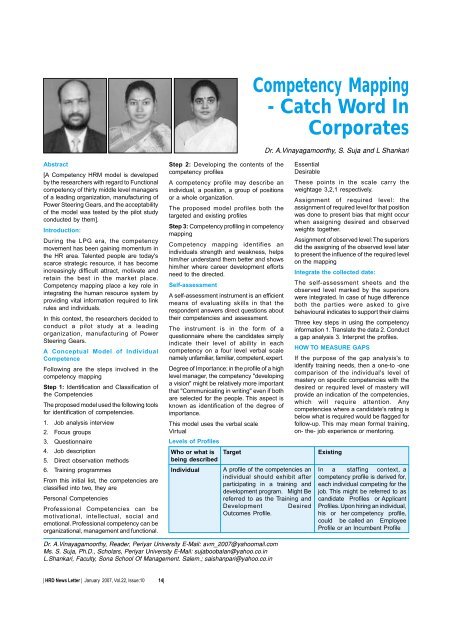New Year Resolutions of a Manager - National HRD Network
New Year Resolutions of a Manager - National HRD Network
New Year Resolutions of a Manager - National HRD Network
Create successful ePaper yourself
Turn your PDF publications into a flip-book with our unique Google optimized e-Paper software.
Competency Mapping<br />
- Catch Word In<br />
Corporates<br />
Dr. A.Vinayagamoorthy, S. Suja and L Shankari<br />
Abstract<br />
[A Competency HRM model is developed<br />
by the researchers with regard to Functional<br />
competency <strong>of</strong> thirty middle level managers<br />
<strong>of</strong> a leading organization, manufacturing <strong>of</strong><br />
Power Steering Gears, and the acceptability<br />
<strong>of</strong> the model was tested by the pilot study<br />
conducted by them].<br />
Introduction:<br />
During the LPG era, the competency<br />
movement has been gaining momentum in<br />
the HR area. Talented people are today's<br />
scarce strategic resource, it has become<br />
increasingly difficult attract, motivate and<br />
retain the best in the market place.<br />
Competency mapping place a key role in<br />
integrating the human resource system by<br />
providing vital information required to link<br />
rules and individuals.<br />
In this context, the researchers decided to<br />
conduct a pilot study at a leading<br />
organization, manufacturing <strong>of</strong> Power<br />
Steering Gears.<br />
A Conceptual Model <strong>of</strong> Individual<br />
Competence<br />
Following are the steps involved in the<br />
competency mapping<br />
Step 1: Identification and Classification <strong>of</strong><br />
the Competencies<br />
The proposed model used the following tools<br />
for identification <strong>of</strong> competencies.<br />
1. Job analysis interview<br />
2. Focus groups<br />
3. Questionnaire<br />
4. Job description<br />
5. Direct observation methods<br />
6. Training programmes<br />
From this initial list, the competencies are<br />
classified into two, they are<br />
Personal Competencies<br />
Pr<strong>of</strong>essional Competencies can be<br />
motivational, intellectual, social and<br />
emotional. Pr<strong>of</strong>essional competency can be<br />
organizational, management and functional.<br />
Step 2: Developing the contents <strong>of</strong> the<br />
competency pr<strong>of</strong>iles<br />
A competency pr<strong>of</strong>ile may describe an<br />
individual, a position, a group <strong>of</strong> positions<br />
or a whole organization.<br />
The proposed model pr<strong>of</strong>iles both the<br />
targeted and existing pr<strong>of</strong>iles<br />
Step 3: Competency pr<strong>of</strong>iling in competency<br />
mapping<br />
Competency mapping identifies an<br />
individuals strength and weakness, helps<br />
him/her understand them better and shows<br />
him/her where career development efforts<br />
need to the directed.<br />
Self-assessment<br />
A self-assessment instrument is an efficient<br />
means <strong>of</strong> evaluating skills in that the<br />
respondent answers direct questions about<br />
their competencies and assessment.<br />
The instrument is in the form <strong>of</strong> a<br />
questionnaire where the candidates simply<br />
indicate their level <strong>of</strong> ability in each<br />
competency on a four level verbal scale<br />
namely unfamiliar, familiar, competent, expert.<br />
Degree <strong>of</strong> Importance: in the pr<strong>of</strong>ile <strong>of</strong> a high<br />
level manager, the competency "developing<br />
a vision" might be relatively more important<br />
that "Communicating in writing" even if both<br />
are selected for the people. This aspect is<br />
known as identification <strong>of</strong> the degree <strong>of</strong><br />
importance.<br />
This model uses the verbal scale<br />
Virtual<br />
Levels <strong>of</strong> Pr<strong>of</strong>iles<br />
Who or what is Target<br />
being described<br />
Individual<br />
A pr<strong>of</strong>ile <strong>of</strong> the competencies an<br />
individual should exhibit after<br />
participating in a training and<br />
development program. Might Be<br />
referred to as the Training and<br />
Development Desired<br />
Outcomes Pr<strong>of</strong>ile.<br />
Essential<br />
Desirable<br />
These points in the scale carry the<br />
weightage 3,2,1 respectively.<br />
Assignment <strong>of</strong> required level: the<br />
assignment <strong>of</strong> required level for that position<br />
was done to present bias that might occur<br />
when assigning desired and observed<br />
weights together.<br />
Assignment <strong>of</strong> observed level: The superiors<br />
did the assigning <strong>of</strong> the observed level later<br />
to present the influence <strong>of</strong> the required level<br />
on the mapping<br />
Integrate the collected date:<br />
The self-assessment sheets and the<br />
observed level marked by the superiors<br />
were integrated. In case <strong>of</strong> huge difference<br />
both the parties were asked to give<br />
behavioural indicates to support their claims<br />
Three key steps in using the competency<br />
information 1. Translate the data 2. Conduct<br />
a gap analysis 3. Interpret the pr<strong>of</strong>iles.<br />
HOW TO MEASURE GAPS<br />
If the purpose <strong>of</strong> the gap analysis's to<br />
identify training needs, then a one-to -one<br />
comparison <strong>of</strong> the individual's level <strong>of</strong><br />
mastery on specific competencies with the<br />
desired or required level <strong>of</strong> mastery will<br />
provide an indication <strong>of</strong> the competencies,<br />
which will require attention. Any<br />
competencies where a candidate's rating is<br />
below what is required would be flagged for<br />
follow-up. This may mean formal training,<br />
on- the- job experience or mentoring.<br />
Existing<br />
In a staffing context, a<br />
competency pr<strong>of</strong>ile is derived for,<br />
each individual competing for the<br />
job. This might be referred to as<br />
candidate Pr<strong>of</strong>iles or Applicant<br />
Pr<strong>of</strong>iles. Upon hiring an individual,<br />
his or her competency pr<strong>of</strong>ile,<br />
could be called an Employee<br />
Pr<strong>of</strong>ile or an Incumbent Pr<strong>of</strong>ile<br />
Dr. A.Vinayagamoorthy, Reader, Periyar University E-Mail: avm_2007@yahoomail.com<br />
Ms. S. Suja, Ph.D., Scholars, Periyar University E-Mail: sujaboobalan@yahoo.co.in<br />
L.Shankari, Faculty, Sona School Of Management. Salem.; saishanpari@yahoo.co.in<br />
| <strong>HRD</strong> <strong>New</strong>s Letter | January 2007, Vol.22, Issue:10 14|
















